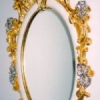Turn your V tool upside down. Does it look like the one on the right?
Not good! The keel is the important middle bevel of a V tool where the 2 'chisels' meet; the blade rests on this keel as it makes its cut. There is a correct, efficient, shape to the keel. There is also an incorrect, inefficient one - such as the conical-shaped keel you see above.
Let me be blunt: A V tool with a conical keel like this is badly made, and hinders rather than helps carvers. In this lesson I'll demonstrate exactly what that conical-shaped keel problem is and show you how to correct it: how to change your struggling V tool into an athlete!

| 20 October 2018 17:57
Ira - I suggest you sharpen it 'normally', then deal with the keel, taking some of that excess metal away.
A crumbly edge means a weak edge and too low a cutting angle will do that - good of you to work out what might be going wrong!

| 18 October 2018 16:43
Hi Chris,
I have a question. I have a pfeil V tool, I sharpened It two times and the edge gets damaged very easily I think. I suspect I may have too low of a cutting angle, so I will re-sharpen and increase it. My question is, it also has a conical keel (which I think I corrected), but as I re-sharpen I think I will need to correct again. Should I correct the conical keel first and then set the bevel angles or set the angles first?
Thanks!

| 31 August 2017 11:11
Rhonda - Well done! And it is indeed an accomplishment.
It doesn't matter what stones you use as long as you arrive at the correct shape, which gets easier and quicker now you have that success under your belt.

| 30 August 2017 23:37
It took a while to get that Swiss Made v tool re commissioned, but I finally got it done. What a feeling of accomplishment! Instead of grinding wheel proper, I used the Worksharp for the initial stage and then diamond stones and your slipstone. By the way, I love the stones you have designed. Thanks so much!

| 18 December 2016 17:31
I'm finding these sharpening videos very helpful, especially the ones that don't use machines to sharpen. Thanks Chris for taking the time.

| 20 July 2016 06:30
Liam - Exactly so. The problem is not with the cutting edge but the conical bulk of metal that tries to follow through the groove it's cutting. So it's all about thinning the keel to something more slender and parallel.

| 19 July 2016 23:19
Hello Mr. Pye,
Since my v tool with a conical heel already has the correct cutting angle, I understand from the video that I simply need to take away the metal with a coarse stone and leave the cutting edge alone, correct? And then I can just refine and polish that with an Arkansas stone?
Thanks for your help,
Liam

| 25 June 2015 08:56
Muhammad - My experience of waterstones is that they wear very quickly: the narrow tool rubbed back and forth soon produces grooves in the stone which can affect the flatness of the bevel. However, if that's what you've got, that's what you've got - and it's far better than nothing at all! Just make sure you dress the stone regularly to keep the surface level.

| 25 June 2015 00:34
Hi Chris, instead using oil coarse stone or table grinder, can i use cheap water stone that made in China? Cause i don't own that type of oil coarse stone and a table grinder.. Thank you.

| 03 January 2014 13:22
First of all, I'm really impressed with the website. Highly informative and well put together. Secondly, a question. Where do you get your slip stones from? No-one I've tried seems to keep anything like the ones you use.
Lastly, I am not so much looking to do carving as an art form per se, but rather as decoration on the headstocks of the guitars I shall be building after I've moved to France, and I should be grateful to hear your thoughts as to what tools I should concentrate on as good quality doesn't come cheap.
Thanks, Ellis Pelham-Glasby

| 27 June 2012 16:08
David - I've given you the full monty in the Sharpen your V tool series but most likely you'll only need to check is the keel angle, which is the equivalent of the cutting angle in a gouge. Other than this, and the possibility of the conical keel shape, the majority of V tools are pretty much ready to go and might only need a little touching up on the finest stone, or stropping. It doesn't really matter at what stage you want to deal with the conical keel but I guess it makes sense to do all the grinding together.

| 26 June 2012 20:47
I guess I should also ask is it even necessary to go through the steps of re-sharpening the V-tool in the same way we would condition a carving gouge? Since in the case of a carving gouge we are trying to establish an inside bevel which would not exist from the factory.

| 26 June 2012 20:45
Chris I just ordered my first V-tool. First, as I go through the process of re-sharpening, do you recommend I go through the other steps first (as covered in the "Sharpen your V-tool videos) and then correct the conical heel, or correct the conical heel first? Second, for a new tool like this should I use the method as shown using the grinding wheel or utilize the course stone, followed by the Arkansas stone and again, should this be done before or after the other steps of sharpening the V-tool? Thanks...Dave

| 22 February 2012 10:08
Fantastic!!! This is a really good part of the series...Something I've waited for and something everyone needs. Thanks.
Roy Almaroad

| 19 February 2012 20:56
Thanks very much Chris...for REALLY providing specifics rel. conical-shape and how to correct.
You are a man of your word..earlier stating you would accomplish this for viewers. In summary, I have been carving for a number of years and consider you as the foremost provider of carving tool info. Your prior books and now...your videos are all superb. Well done!
Ed McKamey